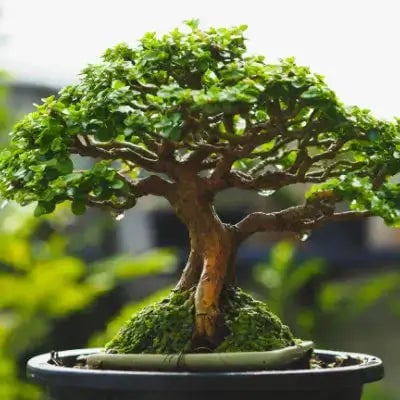A bonsai is a miniature form of more enormous trees and plants grown in pots and containers.
They are great to look at and are created with a lot of care and technique. If you have never planted a Bonsai or are planning to start with it, it would be helpful to know that it requires a lot of patience and time. Most people go to a shop and buy Bonsai plants for their homes, but the absolute pleasure is in actually turning a plant into Bonsai on your own.
You can create your Bonsai by cutting and pruning with a specific technique. In the beginning, you would require a lot of plants to work upon, and it might take several years actually to make your bonsai plant. Before starting, you need to take a few plants and picture how you would like your Bonsai to be. Do not start by pruning it as soon as you buy the plants. You should be able to visualize what you want by finding its trunk line, and then you can start with its pruning. It would help if you started slowly because a bonsai plant would take years of care and technique in pruning, styling, and nourishing. It is also recommended not to directly start working on the plant's roots as you may kill it if you do not recognize the plant's main root.
There is so much care and time that goes into creating a bonsai that a good bonsai can even sell for thousands of dollars in the markets.
Practicing and learning more about bonsai plants would help you to get the perfect Bonsai. There are many books and magazines available that provide detailed information about creating a bonsai. You can refer to these books and do some research before planning to create bonsai plants.
Buy plants in bulk from a nursery and start working on them. You will require a lot of time and plants to master your skills and turn a plant into a bonsai.
Creating a Serene Garden with Bonsai Plants
Your backyard garden is more than just a green space; it transforms into a tranquil sanctuary where you can unwind and explore your creative potential while connecting with nature. Integrating bonsai plants into your garden space creates both charm and sophistication. Bonsai is an ancient East Asian art form where miniature trees are cultivated in containers and shaped through careful styling and pruning to achieve a natural artistic look. Integrating a traditional garden layout with bonsai techniques creates an outdoor space that perfectly balances color, texture, and tranquility.
Your garden design should begin with an evaluation of the space you possess. Document the level of sunlight exposure along with soil quality and climate conditions. Most bonsai plants need bright but indirect sunlight to grow correctly, yet some species can survive in areas of partial shade. Research the individual requirements of each plant because junipers and pines require outdoor conditions with temperature fluctuations. In contrast, ficus and jade can thrive indoors in limited space or cold weather. By understanding what each bonsai needs, you can design a garden that supports the optimal growth of all your plants.
Determine the best way to include bonsai in your garden arrangement. Gardeners sometimes place bonsai in center positions on decorative stands, which enables complete visibility of each miniature tree's detailed features. To make these unique trees stand out, you can plant bonsai in flower beds or raised planters among ornamental shrubs. Bonsai should enhance the garden's design scheme and avoid appearing misplaced. Evaluate different textures and colors to bring out the unique features of the trees. Using groundcover plants alongside subtle stones or moss creates an aesthetic harmony that brings a quiet Japanese garden to mind.
A garden containing bonsai trees requires ongoing maintenance and careful supervision. Outdoor plants require watering and pruning during regular intervals, while bonsai trees need precise watering schedules to prevent their tiny roots from drying out. Consistent pruning helps preserve the small form and stimulates robust development in bonsai. Clean and sharp tools are used to precisely remove dead or crowded branches to achieve balanced growth and maintain the iconic appearance of bonsai trees. Check your bonsai soil conditions and plan to report it regularly every two to three years. The roots stay healthy while growing freely, which leads to a longer life and more vigorous plant growth.
Build a peaceful setting to enjoy your garden space alongside your bonsai collection. Create a cozy sitting area, add stepping stones to direct foot traffic, or build a small water element to produce soothing sounds. Small elements such as wind chimes, lanterns, and statues help create a peaceful garden atmosphere that provides a serene escape from everyday life pressures.
When you choose bonsai that enhance and maintain your garden correctly, you create a beautiful nature exhibit that encourages appreciation of nature's beauty. The centuries-old tradition of bonsai becomes evident through each meticulously trimmed branch and fragile leaf, which transforms your garden into a picturesque and serene sanctuary when incorporated into its design.
Read more

You can Take a Step Toward SustainabilitySustainability is something that you can start accomplishing today. It is a worthwhile goal that will produce benefits for you and those around you. These b...

9A large number of people are interested in growing their fresh fruits and vegetables by planting home gardens. Many people enjoy their gardens and fresh produce throughout the growing period, and ...


